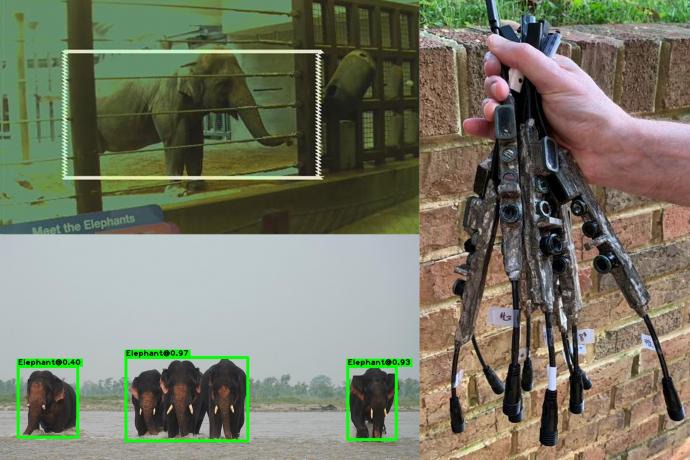WildEyes™ AI: Helping to Save Wild Elephants and Prevent Human-Elephant Conflict
Published 08-12-20
Submitted by RESOLVE

RESOLVE™s WildEyes AI camera system uses AI to detect elephants and transmit alerts, helping to prevent human-elephant conflict and improve research efforts. See full caption at the bottom of the page.
On World Elephant Day 2020, the NGO RESOLVE and the AI software company CVEDIA announce a novel solution to reduce harm to wild elephants and the humans who live near them. Over the past two decades, Human-Elephant Conflict (HEC) has become a major cause of population declines of these iconic mammals in Asia and Africa. Crop raiding by elephants threatens community livelihoods, food security, and human fatalities, often prompting retaliatory killings of endangered elephants. This conflict stresses the most marginalized rural communities, for example, causing over $10 million in crop and property damage annually in Sri Lanka[1] and $600,000 worth of crop damage in Tanzania in 2019.[2]
A scalable solution to this challenge requires a low-cost technology to detect elephants and transmit alerts to wildlife managers and communities to prevent conflict situations before they occur. Using new advances in artificial intelligence technology, RESOLVE’s camera system, called WildEyes™ AI, now enters the field. The small cameras work remotely, hidden in a tree above the reach of elephants, and when the camera’s motion sensor is triggered, it uses computer vision to detect elephants in the frame and transmits those images in near-real time to the cell phones of village guardians.
In tech speak: A sophisticated AI algorithm detects elephants based on synthetic data models created by CVEDIA, running on the Intel Movidius vision processing unit (VPU) embedded in the WildEyes AI camera. The camera remains asleep until the motion sensor is triggered and then, leveraging the AI algorithm, the Intel VPU filters out false triggers. By filtering “on the edge” i.e., only transmitting true positives of elephants, the camera conserves vital battery life. Due to the VPU’s low power requirements, WildEyes AI can run for more than 1.5 years on a single charge of its small rechargeable Lithium Ion battery—a game changer for a field-based sensor. The image of the elephants can be sent over a GSM network, or via a long-range radio link in areas without cell connectivity, in under two minutes from the camera, to the Internet, and back to the local guardians, completing the loop.
“This wildlife camera system, created by engineer Steve Gulick at RESOLVE, can detect elephants before they enter into conflict. With the tremendous partnership and support of Intel and CVEDIA engineers, we can contribute to reducing one of the world’s most pressing wildlife management problems,” said Dr. Eric Dinerstein, Director of Biodiversity and Wildlife at RESOLVE.
“Elephants are beloved by many but not by the agriculturalists who live near them and grow crops elephants like to eat. Here in India, home to most of the world’s Asian elephants, human-elephant conflict is our major problem. RESOLVE’s very clever WildEyes AI camera system gives us an exciting new tool to detect elephants congregating in known staging sites inside protected areas before leaving them and entering conflict hotspots and corridors. This tech advance will allow rangers and villagers to respond before elephants raid crops, destroy homes, or endanger local villagers,” Dr. Bivash Pandav, Wildlife Institute of India, and noted expert on human-elephant conflict.
“Using our unique approach to creating AI algorithms trained on synthetic data, in under three weeks we were able to create a detection algorithm with high accuracy that processes using very low power inside the camera itself. We’re excited about our partnership with RESOLVE and are just getting started: detectors for other high-value wildlife species are also ready to launch,” Arjan Wijnveen, CEO of CVEDIA.
Enhancing Monitoring of Elephants
The AI elephant detector can also be used to advance the management of elephant populations in tropical forests in Africa and Asia. Current monitoring approaches rely on radio-telemetry, field observations, and aerial surveys and are resource intensive; their limitations are much more pronounced in dense forested environments where the majority of African forest elephants and Asian elephants reside. To retrieve and process data from the field creates a lag time between event and detection, ranging from weeks to months. A network of cameras running the CVEDIA elephant detector strategically positioned within elephant home ranges can autonomously detect elephants 24/7 with high accuracy and near real-time notification capabilities, an affordable alternative to traditional surveys or to support existing monitoring efforts.
The CVEDIA elephant detector has the ability to identify all three elephant species: Asian elephant (Elephas maximus), African savanna elephant (Loxodonta africana), and African forest elephant (Loxodonta cyclotis). Release of cameras running the CVEDIA elephant detector will begin in early September 2020. This work was supported by grants from the Shared Earth Foundation, the Stadler Family Foundation, the Weeden Foundation, and One Earth Philanthropy.
About RESOLVE
RESOLVE is a Washington, DC-based non-profit organization that forges sustainable solutions to critical environmental, social, and health, challenges by creating innovative partnerships where they are least likely and most needed. RESOLVE’s Biodiversity and Wildlife Solutions Program tackles the most pressing conservation problems of our time – the approaching extinction of endangered wildlife and threats to habitats, including tropical forests where most of the world’s species reside – through technological innovation, ambitious global agreements, and targeted land protection.
About CVEDIA
CVEDIA is an AI solutions company creating machine learning algorithms for applications where data is limited or unavailable. We’ve mastered synthetic data for computer vision, using a combination of data science and machine learning against a backdrop of 3D design.
[1] International Elephant Foundation (2018)
[2] Tanzanian Ministry of Natural Resource and Tourism (2019)
Image Caption: The WildEyes AI camera system (right) uses AI to detect elephants and transmit alerts in near-real time to designated personnel, helping to greatly reduce the risk of human-elephant conflict or enhance research and monitoring efforts. Shown here is the technology accurately detecting elephants during lab testing (bottom) and field testing at the Smithsonian National Zoo in Washington, DC (top). Photo credits: RESOLVE and Bivash Pandav.
For more information, please contact:
Eric Dinerstein Director of Biodiversity and Wildlife, RESOLVE
Phone: 2023528918
Mijail Benitez Head of Solutions, CVEDIA
Phone: 703-459-1091

RESOLVE
RESOLVE
RESOLVE builds strong, enduring solutions to environmental, social, and health challenges. We help community, business, government, and NGO leaders get results and create lasting relationships through collaboration. RESOLVE is an independent organization with a thirty-year track record of success.
More from RESOLVE

